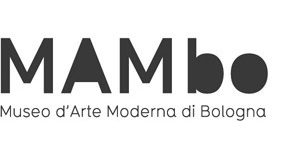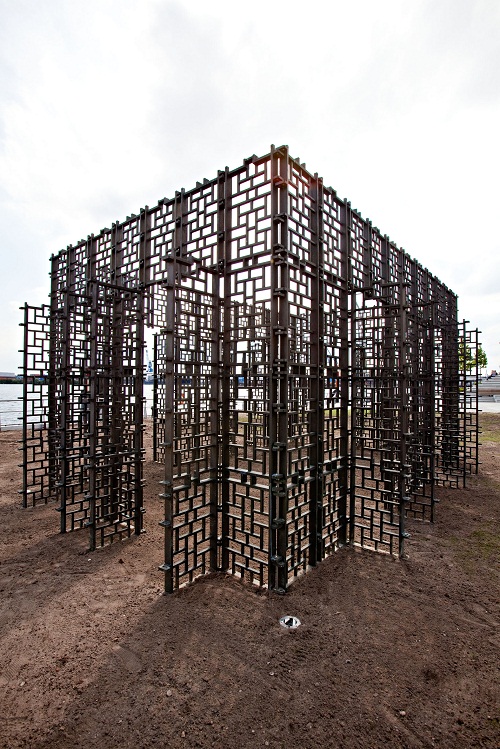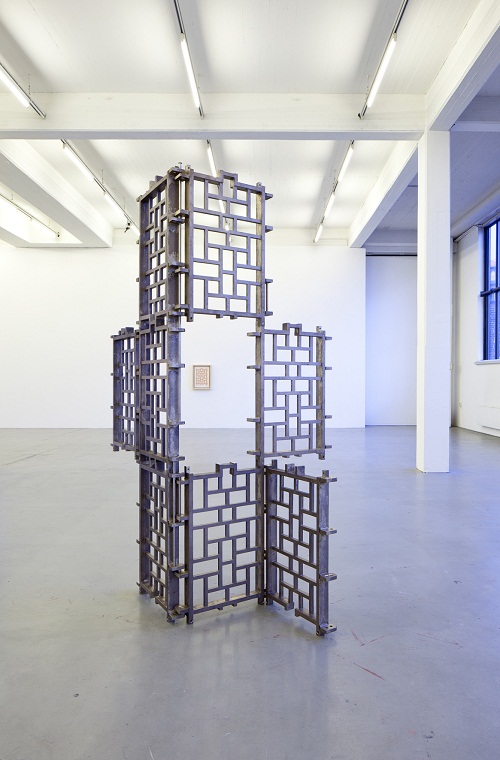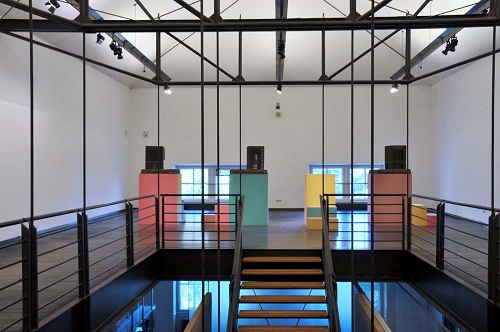

Photo: Plamen Dejanoff – The Bronze House, (144 elementi della facciata / 144 facade elements),
2006 – 2011
Photo Fred Dott, Kunstverein Hamburg, 2011
MAMbo – Museo d’Arte Moderna di Bologna, brings The Bronze House by Plamen Dejanoff to Bologna from June 1 to September 9, 2012. The impressive exhibition is curated by Gianfranco Maraniello and is a stop on the way of the largest bronze monument ever created in the history of Modern and Contemporary Art to its final destination in Veliko Tarnovo, Bulgaria, where it will be assembled into a colossal villa measuring over 600 square meters.
The Bronze House is a long-term project by Plamen Dejanoff, representing the most ambitious undertaking in a career characterized by the artist’s exploration of the bonds between art and economic processes, and the role of the artist and what he can actually do in contemporary society. This quest has made him an unconventional and controversial figure, perennially caught between the deft manipulation of aesthetic strategies proper to late-capitalistic globalized society and an ironic and disenchanted critique of the art system.
The artist began in 2006 to delineate and develop his monumental Planets of Comparison project for his birthplace, Veliko Tarnovo, a charming city of Medieval origin which still conserves traces of its glorious past as capital of the Second Bulgarian Empire. Dejanoff acquired a number of worksites in the city center with plans to build infrastructure made of bronze.
The idea was to create a public cultural center featuring a library, a cinema, a theatre, an exhibition venue, and an artistic workshop. His original intention then expanded to the conception of a broader and more complex undertaking, in which the artist simultaneously plays the roles of manager, curator, architect, designer, and collector.
The success of this venture depends on the joint participation of a network of international partners comprising artists, curators, collectors, museums, galleries, and publishing houses. To finance his idea, Dejanoff created a specific foundation that he promotes through a meticulous
marketing strategy.
When the construction process has been completed, his house-sculptures will be composed of bronze modules embodying advanced engineering principles but each entirely made by hand. They will comprise the elements of the façade, floors, doors, walls, stairways, and couplings holding the entire structure together.

Photo: Plamen Dejanoff
The Bronze House (elementi della facciata / facade elements), 2011
8 elementi in bronzo, ognuno 100 x 70 x 10 cm / 8 bronze elements, each
100 x 70 x 10 cm
Veduta di allestimento della mostra presso / View intallation of the
exhibition at Kunstverein Hamburg, 2011
Photo Fred Dott, Kunstverein Hamburg
The Bronze House is the first of these architectural installations, genuinely habitable sculptures, to assume concrete form in a colossal villa measuring over 600 square meters, which will be assembled in Bulgaria. Progress in the construction process is presented in a traveling exposition that has already visited a number of prestigious European museums, including the Museum of Modern Art, Ludwig Foundation of Vienna (MUMOK), the Austrian Museum of Applied Arts / Contemporary Art of Vienna (MAK), and the Kunstverein of Hamburg. After the Italian show at the Museum of Modern Art of Bologna (MAMbo), it will move on to the Fonds Régional d’Art Contemporain Champagne-Ardenne (FRAC) in Reims.
The extraordinary volumes of MAMbo’s Sala delle Ciminiere exalt the monumentality of the sculptural work in which the artist works with an empty architectural grid as an ideal model, abstracting the decorations of historical buildings and translating them into an open structure.
The choice of a material such as bronze, a classic medium in the arts but completely unconventional in architecture, represents a challenge both in terms of traditional construction methods and regarding the working of the individual elements, which are veritable works of art in themselves and only apparently identical to one another.
The technique of assembling nterlocking modular units is inspired by the pattern of decorative elements typical of the traditional wooden houses in the region, which are an expression of the organic vernacular architecture described by an enthralled Le Corbusier in his Le Voyage d’Orient [The Voyage to the East].

Photo: Künstler im Fokus #9 Plamen Dejanoff. Heads & Tails
Veduta di allestimento della mostra presso / / View intallation of the
exhibition at MAK Permanent Collection Contemporary Art, 2010
© Wolfgang Woessner/MAK
The repetition of the module in a vertical progression of identical units is inspired by the famous Column of the Infinite created by Costantin Brâncuși in 1938 and placed in a public park in the Romanian city of Târgu Jiu, not far from the artist’s birthplace, Hobiţa.
The sculpture—a structure in laminated cast iron over 30 meters high, symbol of the work of art as an inaccessible, ahistorical, and atemporal totem—is characterized by having neither a center nor a beginning or end. It mimics the forms of the old wooden pillars that support the traditional Romanian homes, symbolizing an ideal diagram of the infinite.
A second source of influence stated by Dejanoff in the conception of his work is Donald Judd’s Chinati Foundation created in the 1970s in Marfa, Texas, one of the world’s most spectacular collections of environmental art. The American artist founded an artist colony there to promote the creation of works that are incompatible with normal exhibition venues and museums.
Plamen Dejanoff seems to want to undertake an analogously challenging venture with his decision to found a surprising and unexpected cultural microcosm in the outlying city of Veliko Tarnovo. In spite of its great
historical importance (it is a UNESCO World Heritage Site), the city offers little in terms of attractions and appears not to have progressed in its urban design since the day when Le Corbusier made drawings of it. Dejanoff chose to conduct his experiments here, in this peripheral place, devoid of any meaning that could reasonably produce consensus legitimizing its existence within the contemporary system of art and culture. He undertakes a sophisticated action of branding, not lacking in irony, to make the city among one of the most attractive tourist destinations in Bulgaria under the slogan “Where the future meets the past”.
The conceptual process that led the artist to design a model of the political economy of art, mirroring society and current artistic conventions, is resolved in the creation of a highly evocative total work of art. It sparks reflection on issues such as the mechanisms and purposes of museums in occupying ideological spaces, and the implications of an artist hosting a museum rather than vice-versa. We will not know if Plamen Dejanoff’s gamble on bringing about a process to create recognized value in the current world art system can ultimately be successful until this revolutionary project is complete and functional.
The exhibition concludes with architectural models and prototypes, sketches, drawings, and collages that provide an in-depth illustration of the various preliminary phases of development of the work, as well as a number of installations that lie somewhere between conceptual and hyper-pop imaginary art: toys, dogs, vacuum cleaners, flowers, wheels, and furnishings bearing the “Dejanoff” trademark and appearing more like a typical sales display than an exhibition of works of art in a museum. To mark the exhibition an Instant Book has been published by Edizioni MAMbo in a bilingual edition (Italian / English) containing an essay by Gianfranco Maraniello with excerpt’s from Plamen Dejanoff’s letters, accompanied by an extensive iconographic apparatus.
During the entire period that the exhibition is open, the MAMbo Educational Department will offer guided visits and dedicated activities. For information or reservations: ph. (+39) 051 6496652 (Monday-Friday, 10 am – 1 pm) or (+39) 051 6496611 (Saturday-Sunday, 10 am – 5 pm). The exhibition dedicated to Plamen Dejanoff is part of the program titled Criticism that MAMbo has conducted since 2006. Embodying study and critical thinking on artistic practices and the role of the contemporary museum, the program has involved such artists as Ryan Gander, Paolo Chiasera, Markus Schinwald, Giovanni Anselmo, Christopher Williams, Bojan Sarcevic, Adam Chodzko, Eva Marisaldi, Diego Perrone, Ding Yi, DeRijke\De Rooij, Guyton\Walker, Natasha Sadr Haghighian, Trisha Donnelly, Sarah Morris, Seth Price, Matthew Day Jackson, and Marcel Broodthaers.
MAMbo – Museo d’Arte Moderna di Bologna
Plamen Dejanoff was born in 1970 in Veliko Tarnovo (Bulgaria). He currently lives and works in Vienna.
He has held solo exhibitions in such venues as: Galerie Emanuel Layr, Vienna (2012); Kunsthal Antwerp (2012); Kunstverein, Hamburg (2011); Hafencity, Hamburg (2011); MAK Austrian Museum of Applied Arts / Contemporary Art of Vienna (2010); Pinksummer, Genoa (2010); MNAC National Museum of Contemporary Art, Bucharest (2009); Galerie Nicola Von Senger, Zurich (2008); Jan Winckelmann, Berlin (2007); MUMOK Museum of Modern Art Ludwig Foundation, Vienna (2006); Gallery Space, Bratislava (2005); La Salle de Bains, Lyon (2004); Quarantine Series, Amsterdam (2003); Palais de Tokyo, Paris (2002).
His works have also been featured in a number of collective exhibitions, including: Deutsche Geschichten, GFZK Galerie für Zeitgenössische Kunst, Leipsig (2007); Shanghai Biennale, Shanghai Art Museum, Shanghai (2006); FASTER! BIGGER! BETTER!, ZKM, Karlsruhe (2006); Who´s to follow?, De Appel Foundation, Amsterdam (2004); Prague Biennale, Prague (2003); Berlin Biennale, KW, Berlin (2001); Encounters, Tokyo Opera City Art Gallery, Tokyo (2001); The Constructing of an Image/Germany, Palazzo delle Papesse, Siena (2001); Expanded Design, Salzburger Kunstverein, Salzburg (1999); Dream City, Kunstverein München, Munich (1999); After
the Wall, Moderna Museet, Stockholm (1999).
Per ulteriori informazioni / For further information:
www.mambo-bologna.org











No comments so far ↓
Nobody has commented yet. Be the first!
Comment